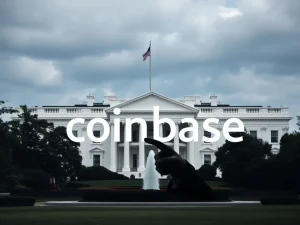Impending Showdown: EU Readies Crippling 20% Tariffs on US Goods Amid Escalating Transatlantic Trade War

In an increasingly interconnected global economy, geopolitical tensions often ripple through financial markets, influencing everything from traditional stocks to the volatile world of cryptocurrencies. Investors in digital assets, keenly aware of market sentiment, are closely watching a brewing storm across the Atlantic. The European Union is preparing to impose significant EU tariffs on US goods, a direct response to mounting pressure from key members like Germany and France, and a looming August 1 deadline set by the Trump administration. This escalating trade friction threatens to reshape global commerce and inject further uncertainty into an already dynamic market landscape.
Escalating Tensions: The Heart of the US Trade Dispute
The transatlantic trade relationship, long a cornerstone of global economic stability, is now under considerable strain. Germany and France, two of the EU’s most influential economies, are leading the charge to compel the European Union to prepare for significant retaliatory measures against the United States. Their demand is clear: unless the U.S. reverses its course on a new round of trade penalties by August 1, the EU must act decisively. This intensified pressure comes after a period of stalled negotiations with the Trump administration, highlighting a significant shift in diplomatic strategy.
Germany, which had previously advocated for patience and direct dialogue, has notably reversed its position. This change signals a hardening resolve within the EU, driven by the perception that the bloc must not appear vulnerable or without leverage in the face of perceived coercion. The shift indicates a growing consensus that proactive measures are necessary to protect European economic interests.
Germany and France’s Pivotal Role in EU Tariffs
The push by Germany and France is not merely symbolic; it reflects a deep concern over the potential impact of US trade policies on European industries. Their insistence on preparing EU tariffs underscores a strategic pivot within the bloc. Initially, there was a preference for de-escalation and negotiation. However, the recent communication from the Trump administration, specifically a letter warning of 30% reciprocal tariffs by August 1, has acted as a catalyst.
One diplomat characterized Germany’s change as a “180-degree turn in a few days,” illustrating the rapid evolution of sentiment within the EU. This collective hardening of resolve emphasizes a shared understanding that the EU must project strength and preparedness. The internal dynamics within the EU, while complex, are increasingly aligning towards a unified, robust response to safeguard the bloc’s economic sovereignty.
The Anti-Coercion Instrument: EU’s ‘Nuclear’ Option in the Transatlantic Trade War
Central to the EU’s strategy is the potential activation of the Anti-Coercion Instrument (ACI). This groundbreaking policy tool, if deployed, would mark a significant escalation in the ongoing transatlantic trade war. The ACI is designed to give the EU broad powers to counteract economic coercion from third countries. Its potential measures are extensive and could include:
- Banning U.S. firms from participating in EU public procurement contracts.
- Revoking intellectual property protections for U.S. companies operating within the EU.
- Freezing trade in specific economic sectors deemed critical.
While Germany and France are proponents of activating the ACI, internal divisions persist. Some member states express reservations, viewing the ACI as a “nuclear” option due to its far-reaching implications and the potential for severe retaliatory actions from the U.S. A diplomat noted a “silent majority against triggering the ACI,” highlighting concerns over its use given the fluid nature of the situation. Despite these reservations, the tool’s existence and the serious consideration of its deployment signal the EU’s determination to employ all available instruments to defend its economic interests.
Unpacking the EU’s Retaliatory Tariffs Strategy
Beyond the ACI, the EU has a concrete, two-stage plan for imposing traditional retaliatory tariffs on billions of dollars of U.S. goods. This strategy demonstrates a calibrated, yet firm, approach to economic pressure. The plan unfolds as follows:
- First Round (August 6): The EU intends to impose 20% tariffs on approximately €21 billion worth of American imports. This initial list includes consumer goods such as chicken and jeans, targeting sectors where the impact on U.S. producers would be noticeable.
- Second Round (Vote on August 6): A second, more substantial round of tariffs is slated for a vote on the same day. This phase could hit €72 billion in goods, potentially affecting major U.S. industries. Products under consideration include Boeing aircraft and American bourbon, signifying a move towards higher-value and symbolically important imports.
- Third Unannounced List: The EU is also developing a third, currently undisclosed, list of targets. This list is expected to focus on U.S. services, specifically digital platforms. Measures could include taxes on online advertising revenue, directly challenging major American tech firms and their business models within the European market. This move would represent a significant escalation, broadening the scope of the dispute beyond traditional goods.
This multi-pronged tariff strategy showcases the EU’s intent to apply pressure across various sectors of the US economy, aiming to maximize impact and compel a change in US trade policy.
Trump Trade Deadline: A Firm Stance from the US
The United States has maintained a firm position regarding the August 1 Trump trade deadline. Treasury Secretary Scott Bessent reiterated that this date is a “hard deadline” for resolving the ongoing trade dispute. He issued a clear warning: if the issues remain unresolved, the U.S. tariffs would “boomerang back to the reciprocal level,” implying further escalation of duties on European goods.
Adding to the tension, the Trump administration has already rejected a proposed framework deal aimed at de-escalating the situation. The U.S. insists on raising its current 10% tariff to a permanent 15% or higher. Conversely, the EU sought exemptions from proposed U.S. levies on critical sectors such as cars, steel, and aluminum, requests which were denied. This divergence in demands highlights the deep chasm between the two economic powers and the difficulty in finding common ground.
Beyond Tariffs: The Broader Implications for Global Trade
While the immediate focus is on tariffs and trade instruments, the implications of this transatlantic dispute extend far beyond. A full-blown transatlantic trade war could have significant repercussions for global supply chains, consumer prices, and overall economic growth. Businesses on both sides of the Atlantic face increased uncertainty, potentially leading to delayed investments and disrupted trade flows. For the broader global economy, a protracted trade conflict between two of the world’s largest economic blocs could dampen investor confidence and contribute to market volatility, a factor that crypto investors are always monitoring.
The dispute also raises questions about the future of multilateral trade agreements and the role of international institutions in resolving such conflicts. The EU’s willingness to activate tools like the ACI could set a precedent for how other nations or blocs respond to perceived economic coercion, potentially ushering in a new era of trade diplomacy.
What Lies Ahead? The Path to Resolution or Further Escalation
Despite the looming threats, formal retaliation has not yet materialized. The European Commission maintains its focus on negotiations, with spokesperson Olof Gill stating that “our laser focus is on negotiations and that will be our priority for the moment.” This suggests that while the EU is prepared for escalation, it still prioritizes a diplomatic resolution.
However, the EU’s readiness to escalate is undeniable. Diplomats describe the ACI as a “calibrated response”—a tool that could range from a “sniper rifle” to a “bazooka” depending on member-state consensus. The outcome hinges critically on whether the U.S. retreats or modifies its stance before the August 1 deadline. If not, the EU’s multi-pronged strategy—combining legal, economic, and sector-specific measures—could fundamentally reshape transatlantic trade dynamics for years to come. The bloc’s message is unequivocal: it will not tolerate perceived coercion without a proportional response.
Frequently Asked Questions (FAQs)
Q1: What is the primary reason for the escalating trade dispute between the EU and the US?
A1: The dispute is primarily driven by the Trump administration’s proposed new round of trade penalties, including a potential increase to 30% reciprocal tariffs, which the EU views as coercive. This has prompted key EU members like Germany and France to push for retaliatory measures unless the U.S. abandons its plans by August 1.
Q2: What is the Anti-Coercion Instrument (ACI) and why is it significant?
A2: The ACI is a new EU policy tool designed to counteract economic coercion from third countries. If activated, it could ban U.S. firms from EU public contracts, revoke intellectual property protections, and freeze trade in specific sectors. It’s considered a ‘nuclear’ option due to its broad and significant potential impact, making it a powerful deterrent in the transatlantic trade war.
Q3: What specific types of US goods are targeted by the EU’s initial 20% EU tariffs?
A3: The first round of EU tariffs, set for August 6, will impose 20% duties on approximately €21 billion worth of American imports, including consumer goods like chicken and jeans. A second round could target items such as Boeing aircraft and bourbon.
Q4: How has Germany’s stance on the trade dispute evolved?
A4: Germany initially advocated for patience and direct dialogue with the Trump administration. However, following recent developments, particularly Trump’s letter warning of 30% reciprocal tariffs, Germany has made a ‘180-degree turn,’ now intensifying pressure on the EU to prepare retaliatory tariffs, emphasizing the need for the EU to show leverage.
Q5: What is the significance of the August 1 deadline mentioned by the US Treasury?
A5: Treasury Secretary Scott Bessent stated that August 1 is a ‘hard deadline’ for resolving the trade dispute. If unresolved, the U.S. warns that its tariffs would ‘boomerang back to the reciprocal level,’ indicating further escalation of duties on European goods. This deadline puts significant pressure on the EU to find a resolution or face direct economic consequences.








